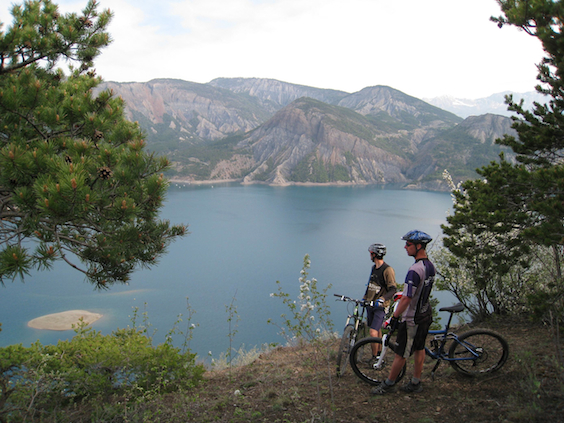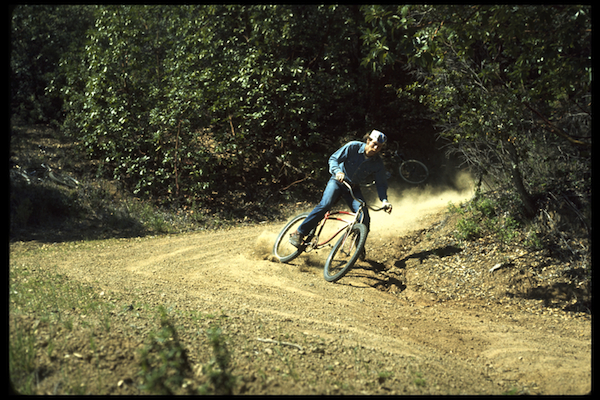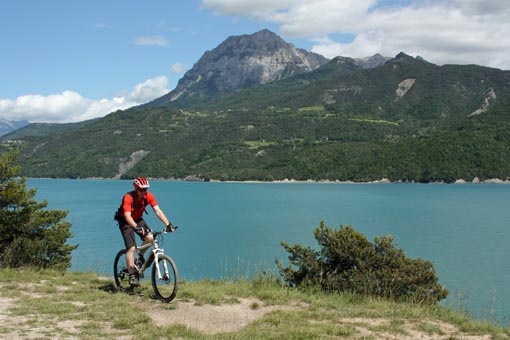Ultimate Guide to Hut-to-Hut Snowshoeing: Essential Kit List and Tips for Your Winter Adventure
There’s something special about moving quietly through the Alps on snowshoes: the gentle crunch of
Read MorePosted 11-06-2013 by Sally Guillaume

There has been a real boom in mountain biking in Europe over the past few years. There are more and more waymarked mountain bike trails, ski resorts are opening in the summer to cater for bikes, and specialist centres have popped up all over the place with graded trails, jump parks and all the latest facilities encouraging people to get out on their bikes and explore the mountains.
What are the different types of mountain biking?

Joe Breeze on one of the first mountain bikes in the USA
The sport of mountain biking has evolved over the years and has diversified into many different disciplines. It has come a long way since its creation in the USA in the 1960s. This article focuses on what is known as cross country mountain biking (XC).
What are cross country bikes like?
XC bikes are at the lighter end of the mountain bike spectrum making the ascent that little bit easier. They range between 7-15kg. There are 3 main types of XC bikes: ‘rigid’ which have no suspension, ‘hardtail’ which have a front suspension, or ‘full suspension’ which have a front and back suspension. The suspensions can have between 4 – 6 inches of ‘travel’…the more suspension travel you have, the more comfortable the ride! Remember to block your fork(s) in easy ascents otherwise all your energy will get absorbed by the bike and lost.

We’ve put our heads together with local mountain bike guides to give you 5 top tips that will help make your XC mountain biking experience more enjoyable!
Good preparation is the key to an enjoyable and safe outing. In the Alps a colour grading system is used, the same as the ski runs. Routes are marked on mountain bike specific maps and are either green (which are graded easy), blue, red and black. They increase in technical difficulty, distance and ascent. Please don’t under estimate the routes and bear in mind when in the mountains there will always be some ascent! Try to choose routes that are within the capabilities of all group members. These mountain bike specific maps are not very detailed, so we recommend carrying an IGN map (Ordnance Survey ) with you as back up. Remember to check the weather before you leave and plan your outing accordingly.

The main reason we ride is for fun and we are always happier when we are not huffing and puffing and having to stop every 5 minutes to catch our breath. Pacing yourself is essential if you want to avoid burning out.Learning to hold yourself back and not going hell for leather at the start of the ride is very important, as is staying within your limits and knowing how far you can push yourself. Stopping and starting in an ascent wastes precious energy, so having enough energy to do it all in one go is the aim! Reaching the top with a little bit left in your tank will mean that you won’t be completely exhausted for the descent. You will be able to concentrate more on your technique, pick your lines more easily and are more likely to stay in the ‘zone’….essential for more technical routes
This is one of the most important things you can do to improve your technique…but it’s easier said than done! Fixing on your front wheel makes every obstacle a challenge and every branch or stone could potentially wipe you out. This short-sighted view means that you burn energy unnecessarily as you are fighting against the trail. By focusing further ahead you are able to anticipate and negotiate any obstacles on the path. Your eyes should scan the trail a few seconds ahead of your current position allowing you to make quick decisions about your next move. This technique helps you maintain your momentum as slowing down kills the flow and rhythm of your ride. By looking and thinking further ahead you can set yourself up for tight turns and get yourself in the right gear for sneaky hills. When you are doing it right the trail should flow and you should find yourself flying over obstacles that you never thought possible!
Having the correct position on your bike and mastering weight transfer at different times throughout your ride will really improve your bike skills. The basic, ready for anything descent position should definitely be in your list of positions to master. You should be out of your seat, your pedals should be level, body position relaxed and your weight should be central over the bike. When the descent starts you should continually move back on your bike, adjusting your position further back the steeper the slope is. When climbing, you should move your body weight forward to keep your front wheel from lifting up. You can be out of your seat or on the front of your seat with the upper part of your body bent forwards. As you reach the top of the climb you should lift your weight back up again into the ready for anything position. It’s all about shifting your weight at the right time and it should feel fluid and smooth, not stiff and awkward.
Being relaxed on your bike is the key to smooth ride. Often, before you know it you’ve tensed up, locked you elbows and adapted the ‘death grip’! When you are out of your saddle in the descent position, stay loose with a soft grip on the
handlebars, this way you absorb the bumps and don’t waste any energy. Keep your feet at the same level, shoulders relaxed and your elbows and knees supple and pointed slightly outwards. Try braking with only one or two fingers. The more grip you have on the handlebars and the further apart your hands are, the more control and balance you will have. Remember to breathe! Concentrate on maintaining a steady breathing rate so that you don’t hold your breath and go into a state of mountain bike apnoea!
The Southern Alps is a haven for mountain biking, with 100s of well-marked tracks. There is something for everyone with easy wide paths to more technical single tracks.
Undiscovered Mountains have a range of mountain biking trips which cater for all levels. One of our favourites is the Tour of the Champsaur and Valgaudemar (Intermediate to advanced riders) - a beautiful ride on the edge of the Ecrins National Park and the Alps to Provence Mountain Biking Tour. Have look at all our electric mountain biking trips too, especially the Alps to Provence e-bike version of the normal mountain bike tour.
Do remember if you do go out on your own, make sure someone knows where you have gone, it’s always better to go riding with someone as there is safety in numbers. We recommend going out with a guide as they can give you some valuable pointers on technique and can also take you off the beaten track. You can hire bikes and a guide as part of our summer multi-activity holiday .
There’s something special about moving quietly through the Alps on snowshoes: the gentle crunch of
Read More“Will I be fit enough to enjoy snowshoeing in the Alps?” This is one of the most common question
Read MoreEvery summer, the southern French Alps region offers a rare and exhilarating opportunity for cyclist
Read MoreThe higher you go, the better the view - right? It is true that the hours of sweat put in to get to
Read More
0 comments
Submit a comment